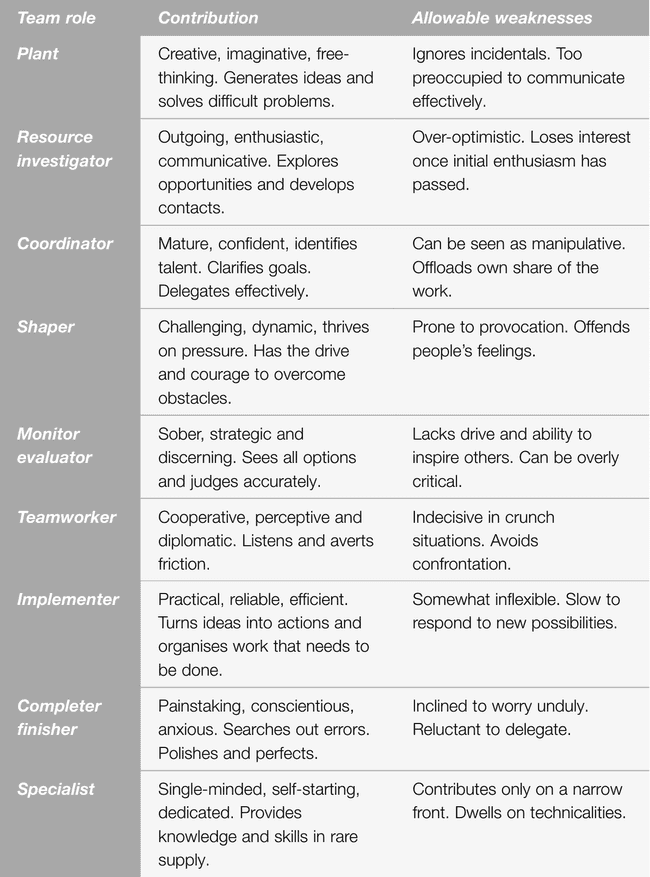Managing work groups: Belbin team roles
A well-known personality test that measures your preference towards nine different roles you can play in a team
Many people nowadays work in groups. Teams can be extremely productive because they allow people with a variety of skills to collaborate in novel ways, but they can also be quite dysfunctional. Understanding the diverse roles that individuals play in teams is a crucial component of figuring out what makes teams productive. The 'Belbin Team Inventory' is a well-known personality test that assesses your preferences for nine various team positions.
When to use it
● To develop your own self-awareness in terms of the roles you generally perform in a team context.
● To build constructive working relationships in teams.
● To create and nurture high-performing teams.
Origins
Researchers have been studying team dynamics for many years. Henley Business School conducted one of the most famous investigations in the early 1970s (outside London). Under the guidance of Dr. Meredith Belbin, researchers studied the dynamics of competing teams during an executive training program. During team meetings, they kept track of the various types of contributions made by members, as well as how effective the teams were at their tasks.
Based on the team members' performance in multiple IQ tests, the researchers projected the high-intellect teams to perform better. The highest-performing teams, on the other hand, were those in which team members played a diverse range of roles. Some teams, for example, had an excessive number of people who wanted to lead, while others had an insufficient number. Based on their findings, Belbin and his colleagues identified nine distinct 'team roles' that people commonly play in groups.
Many later research have built on Belbin's work and even questioned some of his conclusions. However, the underlying idea that people must play distinct roles in order for teams to function well has received widespread support. Many companies have since used Belbin's methodology to better understand individual and team behavior.
What it is
People prefer to take on certain responsibilities in a team environment based on their own personal abilities as well as their relationship with the other members of the team. A 'team role' is defined as a proclivity to act, contribute, and interact with others in a specific way. Belbin identified nine such jobs, which he divided into three categories: "action-oriented," "people-oriented," and "thought-oriented." The following table summarizes them.

Each role has a set of usual contributions that an individual offers to a team, as well as a specific weakness associated with that role. These flaws are referred to as "allowable" by Belbin because they don't necessarily prevent the team from reaching its goals as long as people recognize and compensate for them.
How to use it
The Belbin team roles concept can be applied in a variety of situations. Individually, you can utilize it to better understand your own preferred working style and, potentially, to strengthen your strengths in areas where you are weak. In a team setting, this level of self-awareness can be quite beneficial, since it decreases the danger of becoming irritated by those who see their function in the team differently than you do.
The Belbin inventory can be a good approach to analyze the balance between team members before a project begins at the team level (or perhaps just after it has got underway). This can help to reduce some of the unpleasant team dynamics. Sparks can fly on a team with too many Shapers and Coordinators, for example, because these people all want to be in charge. A group with too many Completer Finishers and Specialists, on the other hand, may find it difficult to get started or may lack originality.
The Belbin inventory can also be used at an organizational level to determine which people to put into teams. Of course, because many people are sufficiently skilled to consciously play several roles depending on the circumstances, there is no perfect combination of roles, but it is a good idea to have some people with experience in each of the action, interpersonal, and cognition categories.
Top practical tip
This is vital to remember since teams that have too many members performing one job can rapidly become lopsided. If you're in charge of a team of consultants, for example, be careful not to fall into the trap of having too many chiefs and not many Indians. Prepare to make some purposeful adjustments to the team's make-up, such as bringing in people to address any noticeable holes in the team's profile or reassigning members to other teams.
Top pitfalls
In other words, the largest risk is assuming that your preferred working style, as indicated by the Belbin team role inventory, is your only working style. Knowing your preferences is useful, but being adaptive is far better. It's also helpful to realize that there are many alternative approaches to teamwork, some of which have greater academic foundations than Belbin's. Although Belbin's approach has the advantage of being well-known and intuitive, you should constantly be open to new ways of managing team relationships.
Further reading
Belbin, R.M. (1996) Team Roles at Work. Oxford, UK: Butterworth-Heinemann.
Katzenbach, J.R. and Smith, D.K. (2005) The Wisdom of Teams – Creating the High-Performance Organization. New York: McGraw-Hill Professional.